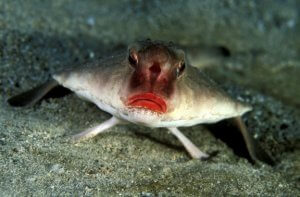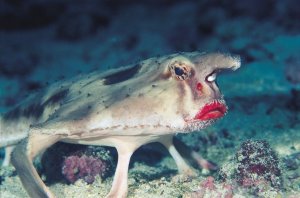What Is the Red-Lipped Batfish?

The red-lipped batfish (or gcocephalus darwini) is a species of actinopterygian fish. That simply means that its fins contain bone, and it’s one of 60 species of the gcocephalidae family.
This species has its habitat only in Ecuador (Galapagos Islands) and Peru. You can find it in the waters of the Pacific Ocean around the Galapagos Islands off the coast of Peru. It lives at depths of between 3 and 76 meters, most commonly at 10 meters. You can also find it on the coasts and in estuaries, generally at the sandy bottoms of reefs.
Anatomical characteristics

This fish measures between 20 and 40 centimeters long. Its triangular shape makes its body and head look as though they’ve been crushed. It has a large head and a relatively short and compressed body, covered in scales, hair and knotty lumps.
The batfish is a tan color, with dark brown spots and two polka-dots on its back. The lower part of its body is light-colored and the upper part is dark. Because of this, it confuses any possible predators as they can blend in with the floor of the ocean.
Its most characteristic feature are its bright red lips, which relates to the sexual attraction within the species. Its curved lips give it a constantly angry appearance. They also have small, cone-shaped teeth that are arranged in bands on their jaws.
The lower part of its body is covered with bony scales and its tail has small spines. The dorsal fin, known as illicium, protrudes from the middle of its face in a horn shape covered with small hairs.
This fin will reach its maximum size during maturity and becomes an extension of the spine.
Behavior and conservation of the red-lipped batfish

Although it’s an aquatic animal, the red-lipped batfish is not a great swimmer. It crawls awkwardly along the bottom of the ocean using its pectoral fins. It also has a small, fleshy anal fin under its propeller-like tail that helps it to move.
The batfish is carnivorous and feeds on other small fish. In addition to this, they also eat marine invertebrates such as crustaceans (shrimps) and molluscs (squids). In order to attract its prey, the batfish secretes a fluid that it uses as bait.
The red-lipped batfish is currently on the Red List of the International Union for the Conservation of Nature (IUCN), under the category of minor concern. This means that it isn’t as yet a threatened species. This is thanks to its habitat at the bottom of the ocean which prevents any direct human influence.
To summarize, this unique fish is a clear demonstration that biological evolution is an unpredictable process, and that it often has surprising results.
The red-lipped batfish (or gcocephalus darwini) is a species of actinopterygian fish. That simply means that its fins contain bone, and it’s one of 60 species of the gcocephalidae family.
This species has its habitat only in Ecuador (Galapagos Islands) and Peru. You can find it in the waters of the Pacific Ocean around the Galapagos Islands off the coast of Peru. It lives at depths of between 3 and 76 meters, most commonly at 10 meters. You can also find it on the coasts and in estuaries, generally at the sandy bottoms of reefs.
Anatomical characteristics

This fish measures between 20 and 40 centimeters long. Its triangular shape makes its body and head look as though they’ve been crushed. It has a large head and a relatively short and compressed body, covered in scales, hair and knotty lumps.
The batfish is a tan color, with dark brown spots and two polka-dots on its back. The lower part of its body is light-colored and the upper part is dark. Because of this, it confuses any possible predators as they can blend in with the floor of the ocean.
Its most characteristic feature are its bright red lips, which relates to the sexual attraction within the species. Its curved lips give it a constantly angry appearance. They also have small, cone-shaped teeth that are arranged in bands on their jaws.
The lower part of its body is covered with bony scales and its tail has small spines. The dorsal fin, known as illicium, protrudes from the middle of its face in a horn shape covered with small hairs.
This fin will reach its maximum size during maturity and becomes an extension of the spine.
Behavior and conservation of the red-lipped batfish

Although it’s an aquatic animal, the red-lipped batfish is not a great swimmer. It crawls awkwardly along the bottom of the ocean using its pectoral fins. It also has a small, fleshy anal fin under its propeller-like tail that helps it to move.
The batfish is carnivorous and feeds on other small fish. In addition to this, they also eat marine invertebrates such as crustaceans (shrimps) and molluscs (squids). In order to attract its prey, the batfish secretes a fluid that it uses as bait.
The red-lipped batfish is currently on the Red List of the International Union for the Conservation of Nature (IUCN), under the category of minor concern. This means that it isn’t as yet a threatened species. This is thanks to its habitat at the bottom of the ocean which prevents any direct human influence.
To summarize, this unique fish is a clear demonstration that biological evolution is an unpredictable process, and that it often has surprising results.
This text is provided for informational purposes only and does not replace consultation with a professional. If in doubt, consult your specialist.








